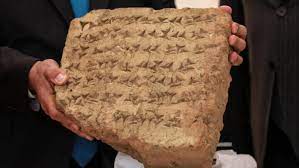Italy Returns ‘Shalmaneser’s Plaque’ to Iraq, Dating Back 2800 Years

Iraq unveiled a 2800-year-old nail-shaped stone plaque that was returned by Italy, as Baghdad seeks to recover looted artifacts from its rich archaeological sites.
The plaque bears the inscription of Shalmaneser III, the Assyrian king who ruled the Nimrud region (north) from 858 to 823 BC.
The circumstances of the plaque’s arrival in Italy are still unclear, but Italian authorities returned the piece to Iraqi President Abdul Latif Rashid during his visit to the city of Bologna on June 14.
Rashid said during a ceremony held on Sunday at the presidential palace in Baghdad to transfer the plaque to the National Museum, “I would like to thank the Italian officials for their efforts and cooperation in returning this piece.”
Leith Majid Hussein, the head of the General Authority for Antiquities and Heritage in Iraq, explained to Agence France-Presse that the plaque bears the titles of King Shalmaneser III, his father Ashur-nasir-pal II, and his grandfather. It also reminds of the construction of the Ziggurat, a massive building in the Nimrud region of Mosul province.
He pointed out that the piece “entered Italy in some way in the 1980s,” where it was seized by the Italian Carabinieri.
Iraqi Minister of Culture Ahmed Fakhir Al-Badrani acknowledged that the circumstances in which the plaque was discovered are still unclear, stating that the discovery may have occurred during archaeological excavations or while working on the Mosul Dam.
He emphasized the importance of this piece, noting that “the cuneiform text on it is a complete text.”
Iraq is the cradle of the Sumerian, Akkadian, Babylonian, and Assyrian civilizations, to which humanity owes the invention of writing and the first cities.
The country has been suffering from the looting of its artifacts for decades, a problem that has worsened due to the chaos caused by the US invasion in 2003, followed by the rise of ISIS in 2014.
The Iraqi President pledged to continue working to retrieve all historical artifacts associated with Iraqi history from abroad, saying, “We hope that the Iraqi Museum will be one of the best museums in the world, and we will work towards that.”
In May, the New York prosecutor returned two ancient sculptures to Iraq, a limestone bull from Mesopotamia and a Sumerian marble statue of a bull from the city of Uruk (Erech) in an archaeological site.
The two sculptures, which were stolen during the Gulf War, secretly arrived in New York in the late 1990s, according to a statement issued by the prosecutor’s office.
The bull sculpture was part of the private collection of Shelby White, an 85-year-old billionaire and benefactor of the Metropolitan Museum.












